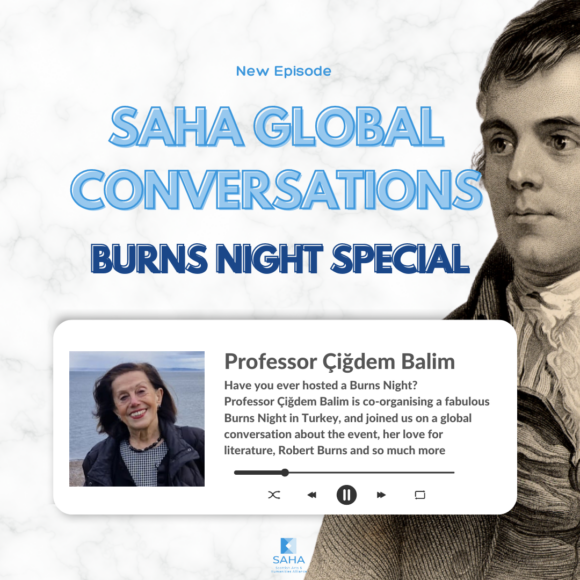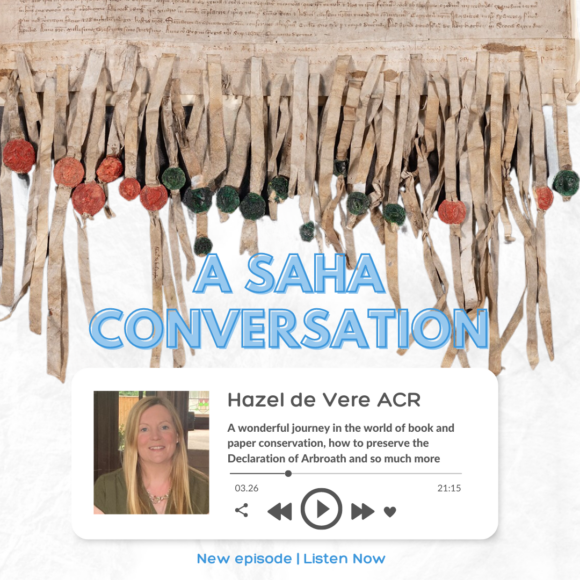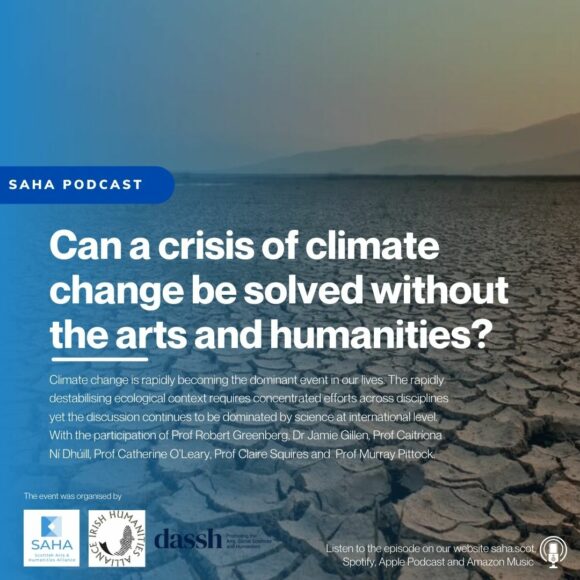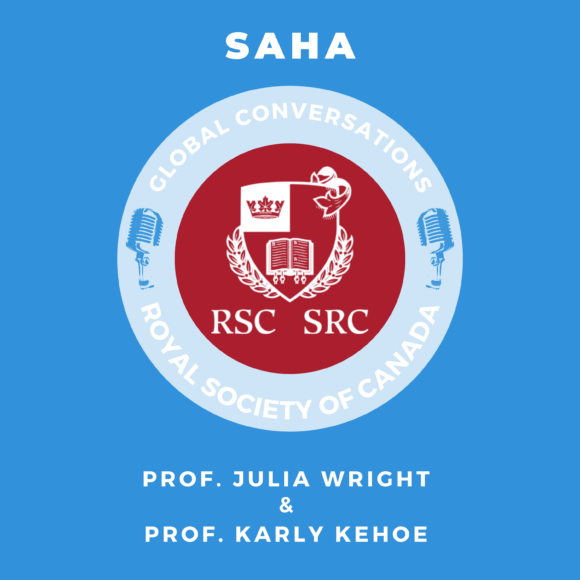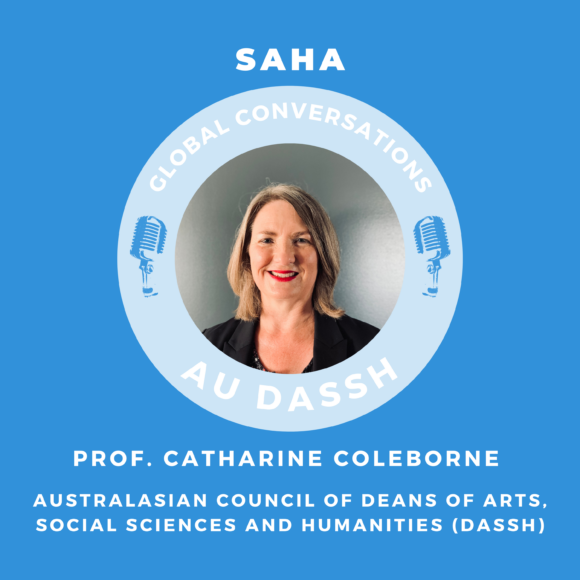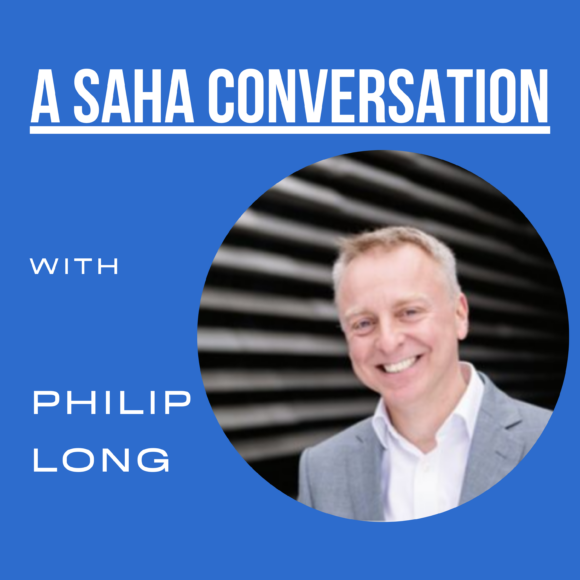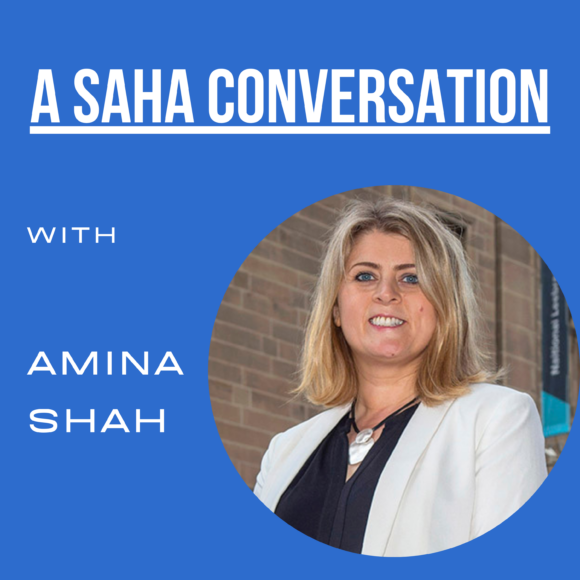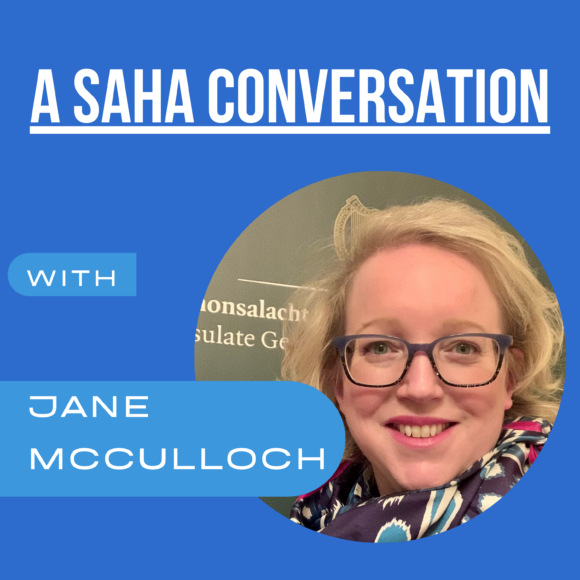Welcome to a new episode of SAHA Conversations, a podcast by the Scottish Arts and Humanities Alliance.
In this episode, we travelled to Dundee to visit the wonderful V&A Dundee and talk to its Director, Leonie Bell.
Leonie Bell has been Director of V&A Dundee, Scotland’s design museum, since October 2020. As Director, she is responsible for leading the organisation from its spectacular home in Dundee’s reimagined waterfront, for delivering the museum’s vision to inspire and empower through design, and for championing design and designers and the infinite possibilities they bring as catalysts of creativity and change.
In this episode Leonie talked about her academic journey, the V&A Dundee and of course the must visit Tartan exhibition.
If you like this episode, please like it and share it on your favourite social media platform.
 Transcript
Transcript
Hello and welcome to a new episode of SAHA Conversation, a podcast by the Scottish Arts and Humanities Alliance.
In this episode, we’ll talk with Leonie Bell, the director of the V&A Dundee, Scotland’s design museum. In the next half hour, we’ll talk about Leoni’s academic journey, which, starting from University of Glasgow, led her to become the director of the V&A Dundee in October 2020. We’ll also talk about the must visit Tartan exhibition, Scottish design, universal design and so much more.
Thank you for joining us on this SAHA Conversation. It is truly a pleasure to talk to you here at the V&A Dundee today.
Thank you for coming. It’s great to be with you.
So, at SAHA, we recognise the importance of an arts and humanities education, and we know that it can lead to many career paths outside academia, and you’re a wonderful example of it. Could you please tell us about your studies and how you became the director of this gorgeous museum?
I can. And I feel slightly fraudulent talking to you because I wasn’t great at uni. I was okay, but I’ll tell you a little bit about the journey to and from uni. So I went to school in St Andrews. I went to a school called Madras College, and it was a really creative place, but it was an academically, high achieving state school in a university town, but it did also really celebrate the arts and creativity. There was an incredible music scene in St Andrews. And then my mum and dad, I suppose I also believe very much in informal education, what happens out with your formal education and how you learn. So my parents always took me to stuff, so I was very familiar with museums, theatres, festivals, and then I hugely embraced, I guess, pop culture and then veered into slightly alternative culture through my pre-teen and then teen year. And all of that kind of matters, I’ll weave all of that together and then I just could not wait to leave St Andrews. I find it a privileged place to be brought up but also, look, it just stood still. And so, Glasgow really called to me as a university, but also equally as a city. So I did English Lit and Language first, but I really just fell in love with Glasgow. Those undergrad years for me, were a love story with Glasgow. I loved it and I was very drawn not just to the uni, but really looked with quite a lot of longing. Longing at the art school as well. And a lot of my friends were at the art school, so I kind of was, I guess, traversing both, and was quite jealous of the art school education and what would happen within a studio based kind of educational environment. As you know, loved Glasgow, loved the buildings, loved the education I got. But absolutely through that love story of Glasgow, fell in love with its clubs, its music scene, its galleries, its artists from spaces, its museums, its know everything that anybody who’d been lucky enough to even spend a day in Glasgow would understand. But also it’s kind of grit and its edge and its glamour and quite often tell this joke that one of the reasons I went to Glasgow yeah, was because it had a great uni, but also because it had a Vidal Sassoon. Like, I was really drawn to Vidal Sassoon, the hairdresser in Princes Square, and in my first week got my haircut there. But actually, it does kind of, I suppose, all makes sense when I think about what I’ve ended up doing. But it was really at post grad level that actually education started to make sense for me in terms of what I would then do. So at postgrad, I did a course which sadly doesn’t exist anymore, which was a partnership between the University of Arts department at Glasgow University and Christie’s Auction House. And Christie’s Auction House was still operating within Glasgow and Edinburgh and of course, in London at the time. And it was called almost like a vocational museum studies qualification. But literally what we went through was 500 years of design and decorative art history within a year. So furniture, glass, textiles, et cetera. And then, because of the museum collections within Glasgow, a fair few of us became very interested in Glasgow style and Macintosh and, of course, and the very important women around Mackintosh and other people at Herbert Link there at the time. So spent a lot of time with Glasgow’s collections, started to understand what happens when what a museum environment is, but also what the value of objects is over time. Because a lot of people that do that course have ended up working in private galleries or in public galleries, but also an awful lot on the auction house industry around, largely Europe and North America. So it was that postgraduate that really started to hone my interest, I guess, in material culture.
And it only lasted one year, you said.
Only lasted one year, but honestly, it was a game changer. And as I said at the beginning, I’m not a hugely academic, theoretical person. I learn on the spot and in conversation, I think, but I still use that bedrock year and the principles of that, I suppose, if you like, design and decorative art history has really, really stayed with me. But I also maybe wasn’t that traditional within that role. So, for example, I’d been lucky enough to, ironically been at the V&A in London visiting, when I must have just been in my early twenties, and I saw an exhibition by a curator that I’m now in touch with who’s still brilliant called Amy Dillahay. And I think she was senior fashion curator at V&A at the time, and she’d done a show in the 90s called I maybe get the name wrong, but roughly surfers, solis, skaters and punks. And it was the V&A and its collections of costume and fashion and textiles. It was a really big show that basically was saying that street style and subcultures influence haute couture. Therefore, what should museums be collecting? So I did my dissertation loosely on that exhibition and on why museums collect what they do and how that’s not actually creating an accurate record, fashion. Because at that time, in the 90, the subcultural use of army wear, sportswear, was really, really prevalent and always has been through history of punk. So that propelled me, that postgraduate qualification, into my first jobs and I’ve not really looked back from them.
That’s very interesting. And you started talking about fashion. I’ve been to the Tartan exhibition, which we’ll talk about in a minute. There is a lot of fashion, there a lot of Vivian Westwood. It’s absolutely beautiful. And if you are in Dundee, please do go and visit. And here in Dundee, this is V&A Dundee, the first design museum in Scotland and the first Victoria and Albert Museum outside London. So you recently celebrated its fifth birthday, happy birthday, V&A, and also revealed that so far, the museum has been visited by 1.7 million people and that to date, it generated 304,000,000 for the Scottish economy. That is impressive. People love art. And obviously, the V&A Dundee, it’s pretty clear from this number. So can you tell us something about the museum in general and what it means for the local art scene, the city and Scotland as a whole to have this museum here in Dundee? And also, I’d love to know your favourite fact about this museum.
Oh, favourite fact? Give me time to think about that. But thank you as well for talking about our fifth birthday, because, yeah, you know, we’re five and it’s been a hell of a five years, hasn’t it, for everybody? I guess we had an opening year where it was like and I wasn’t here then, I’ve been here three years. This, you know, the opening year for the organisation was just like, Whoa. So much interest, so many people coming through, so many people with views and opinions. And then COVID, then literally a year plus a couple of months later, the organisation shut down for two extended periods during COVID And they were important moments for us, actually. They were horrible, because, as you say, everybody that works in the cultural sector, we do it to connect and to gather. Not always to feel the same, but to bring people together for these experiences where we’re sharing and we’re either reflecting or we’re creating moments of actual refraction of what kind of culture means as well. But I like the way you introduced us there, but being in Dundee, that’s really important for us. And Dundee is the only UK’s UNESCO city of design as well. And I think that’s a really important designation for the city to hold. It’s also a textile city, so it’s steeped in design. It’s got an incredible art and design school, it’s got brilliant museums and other art galleries and artists on spaces for a small city. It’s got so much to offer this incredible critical mix of different spaces and networks and organisations. And so for V&A Dundee, we’re quite big in that mix, but I think for us, our focus is very much on design. What design has meant in society and what design means in society now and what design can mean in the future and how it’s this kind of untapped resource for us. It can be something that gives us an indication of what the most exquisite use of materials can bring together, whether that’s like a tiara in our Scottish design galleries or something that’s just every day good design should be a human right. And that’s back to Tartan. One of the things we’re most proud of with Tartan is that the curatorial research that underpins that show is really, really significant. And it has enabled us to identify objects that tell multiple and diverse stories of that iconic textile borrowed from really regarded collections around the world. But alongside it is something called People’s Tartan. And maybe this is the secret, maybe it’s not really a secret because we talk about it quite a lot, but with a people’s Tartan that the curators came up with, I just love it because it’s also saying the state collects people with money collect, local authorities can collect, but it also says we can all collect. And here’s what I value in my life and I love it. So the car that’s upstairs, a guy emailed us saying, do you fancy this car? The last car of the Caledonian production line in Paisley just loved that. And he was just somebody who saw our comms on it and love that. He’s also been part of that kind of curatorial identification of what objects matter in that show.
That is brilliant. and right before we dig into the Tartan exhibition, you mentioned about the importance of design in everyday objects. And in the permanent exhibition, there’s so many things you mentioned the tiara, which is probably not for everyone and not for every day, but you also have the posters for the Fringe Festival, for example, or even just bridges or chairs and a couple of vases, if I remember correctly. How is the impact of design seen by people in their everyday life? are people more conscious of the fact of how design impacts their everyday life, or do you see that as just something that is taken for granted?
I think it’s probably a little bit of both of those things seen and taken for granted. And also I think there’s a barrier around it and it’s possibly to do with the word design itself. I mean design history itself isn’t that old. And it’s interesting that you mentioned the vases, because I think the ones that you maybe mean are they’re from the V&A collection. But there’s a significant collection of Christopher Dresser glass within Glasgow museums as well. So Christopher Dresser is known as the world’s first and certainly the UK’s first industrial designer, meaning that he applied his name to large scale production with factories. He also is known as one of the first designers to travel to Japan when Japan opened up. So you’re talking about in the late kind of 1870s, 1880s. And we’ve got an incredible vase called the Clutha Glass, so the Gallic name for the Clyde. And he embraced the imperfections of the glass making process. So it’s bent, it’s got bubbles in it. It’s absolutely gorgeous. But back to the point about design is every day. No, I don’t think people do think design is every day. And I think that’s something that we’re trying to do. And the stories we tell through our programmes, our events, our shows, everything that. We do that is design doesn’t what we don’t want is for people to think that design is fancy and that it’s just if you’ve got money, that it’s a luxury. We don’t believe that. We think it’s fundamental. It’s the schools our kids are in, it’s the hospitals we’re born in. And we go and we’re in need. It’s our public realm, our pavements, our transport system, our parks, our spaces. Everything around us is designed. It’s what we can evolve of tangibly in our lives. So the cups we use, the TV we put on the phone that we use. But it’s also, I think, a set of critical skills in terms of strategic design and design thinking. So not just the tangible side of design, which I guess is the application of creativity to make something that should make something easier or bring joy. But I think it’s also about trying to encourage all of us to understand that we should expect good design. Crap design creates a lot of inequality and we’re really good at generating crap design, actually. And I think creative education is so important to this. If we can encourage, from the earliest of years, our young people to think critically, which is a creative education, you just ask questions which then just ultimately can make the place better, all of our places better.
This makes me think of universal design. I think you have a fork upstairs in the permanent exhibition part that makes things more accessible to everyone. It can be that someone might have a mobility issue or some different kind of need, and that kind of design makes your life easy, as you mentioned. So the social model of disability would be that it’s the way the world is designed that creates barriers and that’s the big flip that we need. I kind of believe if you design a world where it’s as accessible to the most diverse range of people, that world is better.
That’s true. That’s very nice. You’re absolutely right. And from universal and easy design that makes your life easier, let’s go to something that makes your life prettier, but it’s probably part of many people’s everyday life. Tartan. Now, the Tartan Exhibition is about to end. For those who have not visited yet, you have few more months to do so as it closes in January 2024. Please go and visit. I went. I loved it. Tartan is a distinctive fabric. It’s quintessentially Scottish, it evokes historical connotations and modern fashion. It is universally loved in every corner of the world. So the first part of the exhibition is truly a trip around the world. So it starts with this. Well, is it the oldest piece of tartan that yeah, that’s the first section. And then you move over, you see how tartan is like, you can weave it with little plastic and then you see this gorgeous Vivian Westwood, and then you see pieces from Japan, from Italy, from everywhere. So what inspired this fabulous exhibition? And what was the selection process behind every single of piece of the exhibition?
Yeah, well, the first one. I mean, there’s a professor of Fashion Thinking at Southampton University called Professor Jonathan Faiers, and in 2008 he wrote a book called Tartan. And he in that book in its first edition he probably, when Tartan wasn’t actually as fashionable weirdly in Scotland as it is now, it’s always been part of Scottish life and Scottish culture for a long, long time. He positioned Tartan as this incredible cloth that had a duality to it that no other textile could claim. And we go further and expand his early research in that book. So, again, another reason for really high quality academic research is that book came through his academic career, but we’ve gone further in the exhibition and he was one of the co curators on it really critically, along with three curators here. So we look at how come Tartan, this textile that actually other countries around the world were evolving textiles of similar structure and kind of colour scheme, but Scotland just really, really went for it. So you look at how come Tartan is owned by the military, royal leaders, the establishment, how come it’s also across all sort of easily made and cheaply bought tourism, souvenirs? how come it’s in football stadiums, rock concerts, and how come it’s also still on the catwalk? How come it’s also on the backs of punks and people that also are a part of queer culture and other subcultures? How come everybody feels that they can create an identity from it? So that’s one of the there’s sections in the exhibition, but that refrain of that complex, dynamic duality runs through all of it. And we also look at it beyond just as a textile in fashion. So we look at its influence in architecture, in placemaking, in ceramics, painting, film, performance. There’s a little theatre up there, there’s a little cinema room as well. There’s not really a design discipline that hasn’t used Tartan at some point. The selection process, the team researched this pretty quickly. We really signed off doing that show for our fifth birthday in 2020. The book obviously helped and advanced a lot of the thinking. But in COVID, they did huge amounts of research. And I guess it’s an editorial and curatorial process of you could attend different shows with different objects in it. But the objects that we chose for this showing of Tartan because we do hope to tour it, we’re looking at those plans at the moment, to take it around the world we felt demonstrated best all those exciting stories that we’re trying to say about this textile.
And what is your favourite piece of the exhibition?
Oh, I don’t know. I’m really bad at favourites. I love it as an exhibition, I really love it. We’re really, really going to miss it. I don’t know if I’ve got a favourite, because, as you say, there’s emotional poignant ones. That the oldest bit of the largest fragment of the Glen Affric Tartan at the moment, some of my favourite designers of all time are in there. I just actually love it as a complete experience. I just feel it’s an exhibition that’s got so much energy. But there’s also moments of real reflection. And I love that about it. So I’m going to cheat and just say the whole exhibition.
I think that’s a fair answer. It is beautiful in its entirety, the entire experience. I would describe it as a journey, because you start from the very beginning. So the first Tartan that you could find until the modern usage, even in advertising, so you can see Tartan apply to different types of mediums. Tartan in the Highlands to Alexander McQueen’s catwalk, to the difference and the dichotomy between the sacred and profane. The way that is associated with charitable causes. For example, Doddy’s iconic Tartan suit, which we all know and love. So every piece is iconic in its own way and tells a story. So let’s rephrase the question. What is your favourite story behind a certain piece? It can be multiple pieces as well, but the favourite story told in this exhibition.
Yeah, just to maybe go a little further with your explanation. So we don’t tell the chronological story of Tartan. It’s not in a historic timeline presentation. We look at it first through the grid. So what is it? And then we look at innovation. So how was it made? From humble craft to mass global industry, and then also within markets. So Japan being the biggest martin for Tartan at contemporary time. France’s love of it. And then we look at identity, then we look at power, and then we look at transcendental, which is where Dodi’s suit in, because he created a legend of himself, because he’s fighting one of the most horrendous illnesses that anyone can have. I love the power section, actually. I really love the power section, because I particularly love that Blackwatch by National Theatre of Scotland is in there. I love the way it talks about, through various objects, of how Britain built its empire. And a lot of that was through regiments that were based in Scotland. And Tartan was used to recruit sometimes for battles and causes that people didn’t know why they were giving up their lives. It’s really emotional. You find it in a really emotional section. And then I love that you turn the corner and you can sit in this little cinema and you’ve got what we call the catwalk scene from Black Watch, where it talks about the history of the Black Watch regiment, which is particularly relevant in this area, which is where they were based through their uniform changes. And it’s a really unusual way to present military uniform, because it’s presented as if it’s fashion. But you’re talking about the story of young men over centuries and what was being asked of them, and it’s just really emotional. And then you quickly turn the corner and you get into really rebellious causes. From Jacobites to suffragettes to the independence movement, so people that are using it to then take forward their own political causes. And I just love that spectrum that you get in that one part of the show.
I’m going to ask a cheeky question. How about the toilet loo role in the exhibition? Because that might surprise some people, because I think it’s really be close to the is it close to the Dior bit? The one with the tartan skirt? And then you turn the corner, more or less, and you find..
Yeah, there’s a really brilliant sausage dog made of tartan, which is like, we got what you call them, the things that stop a draught excluder. And actually, that draught excluder is really brilliant. That tartan draught excluder. It’d be hard not to want to take that home with you over winter. Absolutely. And some of the fashion, as you say, there’s a suit of two kings next to one of the Dior dresses for the Duke and Duchess of Windsor, and they’re sublime outfits up there.
And, well, we talked about the current exhibitions here at the V&A. Can you give us a sneak peek of what’s coming next?
Yeah, so next year, we’re doing an exquisite V&A show, which actually had a very short run in London because of COVID looking at kimono, which kimono historically, and how it’s really influenced a lot of kind of popular culture as well. So how one, if you like, dress items, become totemic in what it represents. And we’re really, really delighted to be doing that. Of course, in a Japanese design building, we’ll also be doing something that’s very local, which we’re really proud to be doing, too. We’ll be showing the entire Dundee tapestry, which is similar to the great tapestry of Scotland. Same artist involved, so we’re delighted about that. And then we’re also doing another collaboration with the V&A, looking at their photography collection and looking at the relationship over hundreds of years to now of cameras abilities to create images and the relationships and how cities develop around the world. And there’ll be some really historic kind of artefacts there, but we’ll take that right up to date, how people experience cities now. And as we started the conversation, the role of design and that, and the role of residents and citizens ability to kind of help make that better as well. So that’s all coming next year. So much to look forward to.
Well, thank you very much for joining us on this SAHA Conversation. It’s been truly a pleasure.
Well, thank you so much. It was lovely to talk to you.
Thank you for joining us on this SAHA Conversation. We hope you enjoyed it and learned something new. If you liked this episode, please share it, subscribe and leave us a like on Twitter and Instagram at SAHA_voice and on Facebook at Scottish Arts and Humanities Alliance.

